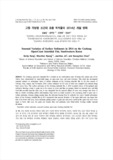

PARTNER
검증된 파트너 제휴사 자료
고창 개방형 조간대 표층 퇴적물의 2014년 계절 변화
방대한 850만건의 자료 중 주제별로 만들수 있는 최적의 산출물을 해피 캠퍼스에서 체험 하세요 전문가의 지식과 인사이트를 활용하여 쉽고 폭넓게 이해하고 적용할수 있는 기회를 놓치지 마세요
18 페이지
최초등록일 2016.06.04
최종저작일
2016.04

-
 * 본 문서는 배포용으로 복사 및 편집이 불가합니다.
* 본 문서는 배포용으로 복사 및 편집이 불가합니다.
미리보기
서지정보
· 발행기관 : 한국지구과학회
· 수록지 정보 : 한국지구과학회지 / 37권 / 2호
· 저자명 : 강솔잎, 양우헌, 진재화, 전승수
목차
서 론
지역 개관
연구 방법
분석 결과
해석 및 토의
결 론
사 사
References초록
고창 개방형 조간대는 황해의 동편, 한국 서남해 연안에 위치하며, 대조차, 개방형 연안, 모래 저질의 특징을 보 인다. 본 연구는 고창 조간대에서 표층 퇴적물의 계절별 퇴적상 변화를 연구하였다. 2014년 2월, 5월, 8월, 11월의 사계 절에 3개 측선을 따라 총 252개 지점에서 표층 퇴적물을 채취하고 분석하였다. 고창 조간대의 2014년 표층 퇴적물은 주로 세립 사질 퇴적물로 구성되며, 계절별로 겨울에 조립하고, 여름에 세립한 경향을 보였다. 연구 지역 인근의 계절별 파랑과 조위 관측 자료에 근거하여, 고창 조간대의 표층 퇴적작용에 영향을 미치는 요인은 파랑이 조석보다 계절의 변화 효과가 큰 것으로 해석되었다. 겨울에 상대적으로 큰 파고의 파랑 영향으로 표층 퇴적물이 조립한 반면, 여름에는 상대적으로 낮은 파고의 파랑 영향으로 세립한 것으로 해석되었다. 고창 조간대의 2014년 퇴적상 공간 분포는 고조대 의 계절별 편차가 저조대에 비해 상대적으로 크게 나타났으며, 고조대 입도가 조립하고 분급이 불량하게 나타났다. 고 조대에서 저조대 방향으로 갈수록 입도가 세립해지고 분급이 양호해지며 계절별 편차가 작아졌다.영어초록
The Gochang open-coast intertidal flat is located in the southwestern coast of Korea (the eastern part of the Yellow Sea), characterized by macro-tidal range, an open-coast type, and sand substrates. This study has investigated seasonal variation in sedimentary facies of surface sediments in the Gochang intertidal flat. In the four seasons of February, May, August, and November, 2014, surface sediments of 252 sites in total were sampled and analyzed along three survey lines. The surface sediments of the Gochang intertidal flat in 2014 consisted mainly of fine-grained sand sediments showing a trend in grain size to be coarser in winter and finer in summer. Based on seasonal wave and tidal level data recorded near the study area, it was interpreted that the seasonal effects of wave were stronger than those of tide as a factor controlling surface sedimentation. High waves in winter resulted in the coarsening trend of grain size in surface sediments, whereas, during summer time, the sediments became finer by relatively low waves. Spatial sedimentary facies of the Gochang intertidal flat in 2014 represented that seasonal deviation of the upper tidal zone was larger than that of the lower tidal zone, hence sediments getting coarser in grain size and poorly sorted in the upper tidal zone. From upper to lower tidal zone, the grain size became finer and sediments were better-sorted, showing smaller seasonal deviations.참고자료
· 없음태그
-
자료후기
Ai 리뷰지식판매자의 해당 자료는 과제를 작성하는 데 큰 도움이 되었고, 내용이 풍부하여 많은 정보를 얻을 수 있었습니다. 정말 추천할 만한 자료입니다. -
자주묻는질문의 답변을 확인해 주세요

꼭 알아주세요
-
본 학술논문은 (주)코리아스칼라와 각 학회간에 저작권계약이 체결된 것으로 AgentSoft가 제공 하고 있습니다.
본 저작물을 불법적으로 이용시는 법적인 제재가 가해질 수 있습니다. -
해피캠퍼스는 구매자와 판매자 모두가 만족하는 서비스가 되도록 노력하고 있으며, 아래의 4가지 자료환불 조건을 꼭 확인해주시기 바랍니다.
파일오류 중복자료 저작권 없음 설명과 실제 내용 불일치 파일의 다운로드가 제대로 되지 않거나 파일형식에 맞는 프로그램으로 정상 작동하지 않는 경우 다른 자료와 70% 이상 내용이 일치하는 경우 (중복임을 확인할 수 있는 근거 필요함) 인터넷의 다른 사이트, 연구기관, 학교, 서적 등의 자료를 도용한 경우 자료의 설명과 실제 자료의 내용이 일치하지 않는 경우
“한국지구과학회지”의 다른 논문도 확인해 보세요!
-
‘위기의 지구’에 대한 인지프레임 비교: 대학교 신입생들 대상으로 15 페이지
본 연구의 목적은 고등학교에서의 지구과학 I 이수 여부에 따른 대학교 신입생들의 ‘위기의 지구’에 대한 인지 프레임을 비교하여 이것이 교육과정을 반영하고 있는지 확인하는 것이다. 이를 위해 정규 교육과정을 거쳐 고등학교를 졸업한 67명에게 위기의 지구에 대해 그림으로 표현하고 그에 대해 설명하도록 했으며, 그림으로부터 각각의 의미 단 위를 추출하였다. 수집.. -
발산 순압 로스비-하우어비츠 파동의 안정성 10 페이지
전구영역 수치모델을 이용하여 순압 로스비-하우어비츠 파동의 안정성을 조사하였다. 본 연구에서 조사한 로스 비-하우어비츠 파동은 강체 회전하는 동서 기본류와 유한한 진폭을 가지는 구면조화 파동으로 구성된다. 로스비-하우어 비츠 파동은 강체 회전하는 동서 평균류의 강도에 따라 정상 또는 비정상의 구조로 나타난다. 수치 실험을 통해 임의 의 다른 두 시간에서 섭.. -
변산반도 국립공원 부안화산암 내의 지질명소 및 지질유산의 가치평가 10 페이지
이 연구는 변산반도 내에 화산암이 분포하는 지역을 중심으로 지질학적 가치를 분석하여 지질명소 및 지질유산 의 가능성을 조사한 것이다. 그 결과 외변산에 위치한 궁항, 솔섬, 모항 등 3곳과 내변산에 위치한 직소폭포, 굴바위, 선계폭포, 울금바위 등 4곳, 총 7곳의 지질명소를 제안하였다. 지질명소 중에서 솔섬과 모항은 지질유산적 가치가 높기 때문에 보존과 ..
문서 초안을 생성해주는 EasyAI
